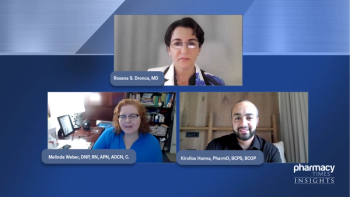
Prescription Discount Programs: Tips
Experts share tips to help patients and pharmacies evaluate and participate in Prescription Discount Programs.
Episodes in this series

Suzanne Soliman, PharmD, BCMAS: How do patients or pharmacies join or participate in a program? If a patient is interested, what would you recommend if someone came to your pharmacy and was asking you about prescription discount programs [PDPs]? How would you recommend them going through step-by-step to do it?
Lisa King, RPh: I would recommend the cards that I found to have the best savings for the patients. For many of the cards, you may have to go online to look up a price. I would help my patients who are older, or those who did not have access to a computer. Or, I would let them know how to go about doing that for themselves and help them in any way possible. Then, as a pharmacy, I believe you just have to contact the prescription discount program and sign up with it so you can become part of their network. I think it is very easy to do, provide your different identification numbers, license, and NCPDP [National Council for Prescription Drug Programs number], that type of thing, and join as well. I am at an independent pharmacy myself, and we have our own discount programs we use, too. It is great.
Suzanne Soliman, PharmD, BCMAS: Definitely, and I think it is important to realize that it is for all types of medications, too. Some people may think it is only for the really expensive medications, but you could use this for any medication, depending upon whatever area. It is not just for chronic disease medications, diabetes medications, or hypertension medications—it is for everything. Pharmacies can join as well. If pharmacies are interested, whether or not they are an independent pharmacy, depending upon who they work with, I know that certain groups have contracted with certain cards. Some of them are accepted, and certain chain pharmacies accept certain ones. I think pretty much anyone can join, but I encountered that as well with patients who did not have access to the internet. Sometimes, they had a smartphone, and so then my technician would help them go through on their smartphone, what to do and how to get the card, which definitely helped. I do not think it is a great idea to have the card sent to the pharmacy. I know that a lot of pharmacies frown upon that, and I have seen them get chucked into the waste basket. I do not think having them in the pharmacy space is a great idea; I think having access somewhere is a better idea.
Lisa King, RPh: Another thing I just thought of too is that so many of the cards will offer different prices at different pharmacies. I would strongly encourage patients to know that that pharmacy where I was working, or you were working, or any pharmacy, is going to get them the best price. I would encourage patients not to go from pharmacy to pharmacy. Filling their different prescriptions at different pharmacies just for the best price is not a good idea because if there are drug interactions or adverse events, different things like that, they can get pushed by the wayside and not come to the forefront where pharmacists can see them, [as opposed to] if everything is being filled in 1 place.
Suzanne Soliman, PharmD, BCMAS: I agree; you want to avoid the whole polypharmacy thing related to that, in terms of drug interactions or multiple physician prescribers, and things like that. Patients may end up taking the same medication twice. It is probably not worth it. I used to tell patients that too; it is not worth your gas money, because you are not going to save the amount you might think you are by shopping like that. What are some counseling points you have given patients to help them when determining it? I know you said that you would look through it with them, but what if they were at home and trying to find the best card? What would you have them do?
Lisa King, RPh: I think, honestly, they can look at home, but they should talk to the pharmacist because the pharmacist is going to know what the best prices are and help them navigate this. Also, often the pharmacist really knows the price of the medications. I encountered many different times where the patient will come in and say, “My doctor said this should be $10,” or whatever it may be, and it’s quite a bit more….
Suzanne Soliman, PharmD, BCMAS: And they think [the prescription is] going to be ready in 5 minutes, but it is not going to be ready in 5 minutes….
Lisa King, RPh: Exactly. I know, and it is funny because where I worked, we had so many clinics that were right across the street. And honestly, the patients’ drive time from the clinic over to the pharmacy was quicker than when we would get the prescription through. The same thing goes with the cost of the medication. Really, the pharmacist knows about the prices of medications. The doctors will oftentimes have those co-pay assistance cards that we talked about earlier, and that is often helpful. They will have them there through the drug representatives, but for discount cards, the pharmacist is key.
Dr. Suzanne Soliman: Definitely, and I think in terms of avoiding fraudulent ones, I have had patients come to the pharmacy and say, “You know what, they asked me for my credit card number, and they asked me for my bank account number.” I would say, “There is no card that would ask you for your personal financial information, and if they do, that is a red flag. That is something you want to avoid and you do not want to be using.”
What about pets? We often have patients who come in for medications for their pets. Would you recommend this for patients who want to use this for their pets?
Lisa King, RPh: Yes; I know some of the cards cannot be used for pets, but with many of them, you can. I think the biggest obstacle we had when using them for pets is that veterinarians do not have NPI [National Provider Identifier] numbers, and the cards have to be able to recognize the doctor in the system. Often, we would have to call the vet to get the their DEA [Drug Enforcement Administration] number, and they were hesitant to provide that because it was not a controlled substance that they were prescribing. We had to explain to the patient and to the veterinarian what was going on with the cards, but there definitely has to be some sort of number identifying the prescriber in order to use the card. That was a workaround we had to do; oftentimes, we would get that DEA number if we did not have it from previous prescriptions. But it is a great way to go, and I can think of so many different dogs we helped in this way. I am in Arizona, and valley fever is extremely prevalent here. A lot of the antifungal medications that we would have prescriptions for would be extremely expensive, and these dogs would have to be on them for months on end. The prescription discount programs were really helpful for people to be able to use with their dogs.
Transcript edited for clarity.
Newsletter
Stay informed on drug updates, treatment guidelines, and pharmacy practice trends—subscribe to Pharmacy Times for weekly clinical insights.
















































































































































































































